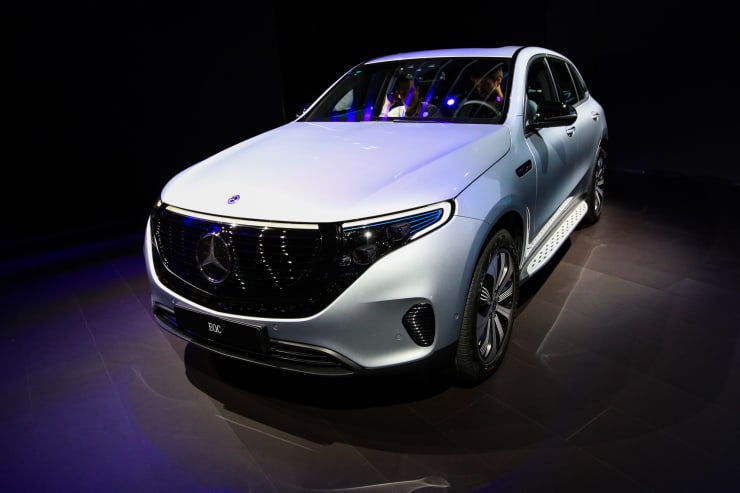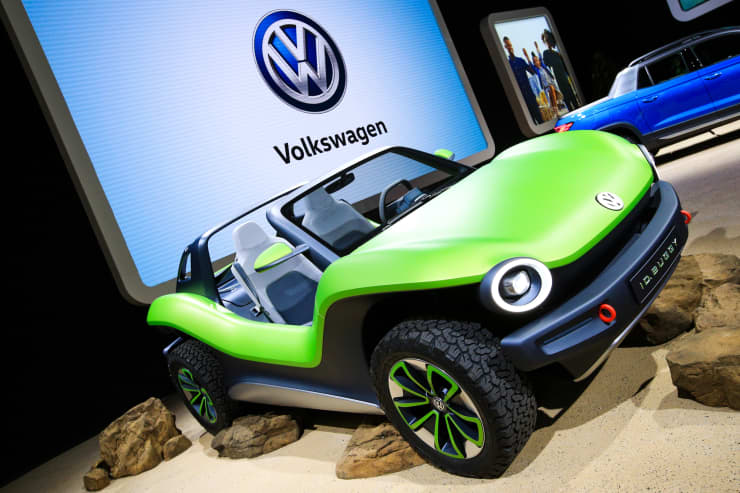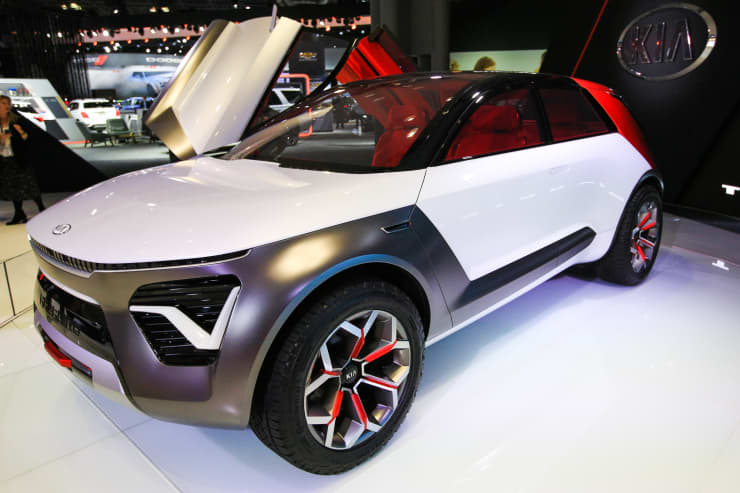
New York auto show previews Tesla’s future competition with more than 40 electric vehicles on display
- More than 40 vehicles using some form of battery power are on display at the New York International Auto Show.
- Two of the three finalists for World Car of the Year at the 2019 New York show are fully electric.
- The Jaguar I-Pace wins Car of the Year, World Car Design and World Green Car for 2019.
It wouldn’t be much of a stretch to call this year’s New York International Auto Show “electrifying,” not when you consider that more than 40 vehicles using some form of electric power are on display at the Jacob Javits convention center.
That includes not only conventional hybrids such as the Toyota Prius, but a long list of more advanced technologies, including plug-in hybrids and pure battery-electric vehicles. And automakers as diverse as Ford, Hyundai and Daimler AG announced plans to roll out dozens more of those plug-based models over the next several years.
“The industry is going through tremendous change, and there’s no better example of that than the number of electrified vehicles now coming to market,” said Mark Schienberg, head of the Greater New York Automobile Dealers Association, the trade group that organizes the annual show in New York that runs through Sunday.

It’s been 20 years since Toyota launched the Prius and Honda debuted the Insight, the first two mass-market hybrid vehicles. And it’s coming up on a decade since the first plug-based models, the Chevrolet Volt plug-in hybrid, or PHEV, and the Nissan Leaf battery-electric vehicle, or BEV, hit showrooms.
Those early models created plenty of buzz but, with the exception of the Prius, generated relatively modest demand. It didn’t help that first-generation electrified vehicles were slow and stodgy and generally not much fun to drive, often taking more than 10 seconds to go from 0 to 60 miles per hour, noted Joe Phillippi, head of AutoTrends Consulting.
It also didn’t help that the first wave of BEVs could barely muster 100 miles per charge — and then only under optimum conditions. Worse, public charging facilities were limited, especially when it came to high-speed “Level 3” technology that could cut charging times to less than an hour.

Things began to change mid-decade with the launch of the Tesla Model S, the first serious entry to extend range to more than 200 miles per charge. The California electric-car maker also began rolling out a network of fast “Supercharger” stations across Canada and the U.S., making it possible to travel extended distances for the first time, without extensive delays.
In a sign of how fast things are changing, two of the three finalists for World Car of the Year at the 2019 New York show are fully electric. The Jaguar I-Pace, a long-range SUV, not only took Car of the Year honors but also was named World Car Design of the Year and World Green Car of the Year.
The New York show is filled with second-generation electric cars, with manufacturers highlighting plans for even more advanced offerings to come. Among the most significant models to debut in New York this past week were:

Named in honor of the world’s first automobile using an internal combustion engine, the special version of the EQC will be the first all-electric model the automaker plans to sell in the U.S. But Daimler AG Board Member Britta Seeger said 10 BEVs will be in Mercedes showrooms by mid-decade and could soon account for 20-25% of the marque’s total sales, most part of a new Mercedes EQ sub-brand.

The old VW Beetle was one of the world’s most popular vehicles — and served as the foundation for the dune buggies that were wildly popular in the 1960s and 1970s. This concept shows what an all-electric buggy could look like. It also hints that a new Beetle will go all-electric. VW last week showed off another electric vehicle, the I.D. Roomzz, at the Shanghai Motor Show. It is investing over $50 million to make electric vehicles.

The new SUV from Ford’s luxury brand starts out with a pair of gas engines but will have a plug-in hybrid alternative available within a year. And brand President Joy Falotico told CNBC an all-electric Corsair is also in development. This approach, offering optional electric drive systems, is expected to become commonplace. Alfa Romeo, BMW, Infiniti, Volvo and other manufacturers are developing similar strategies.

The Korean carmaker’s “everything car” demonstrates the flexibility of electric propulsion. Currently just a concept vehicle, it features knobby off-road tires. But more significant is the fact that the cabin of the HabaNiro is far bigger than its compact exterior would suggest. That’s because it mounts batteries and motors in a skateboard-like platform, freeing up space for passengers and cargo normally devoted to the engine compartment.

While cars are the stars at the New York show, visitors who peek around the corner at the Audi stand will see another very important debut. Electrify America is showing off a next-generation Level 3 charger that punches out seven times more power than original fast-charge systems, at 350 kilowatts. While not all BEVs will be able to drink down power that rapidly, Porsche’s first all-electric model, the Taycan, will be ready.

At that level, an electric vehicle could extend range by as much as 20 miles per minute, meaning a typical time of 10 to 12 minutes for a full charge, or not much more time than it takes to fill a gas tank, said Brendan Jones, the chief operating officer at Electrify America. The start-up, funded by $2 billion from Volkswagen as part of its diesel emissions settlement, plans to set up thousands of fast-charging stations across the U.S. over the next decade.
Whether PHEVs and BEVs will catch on is far from certain, analysts such as AutoTrends’ Phillippi caution. But as prices fall, range grows and charging times improve, they’re gaining more appeal. Sales have been growing rapidly, largely led by the new Tesla Model 3. But the NYIAS shows that motorists will be getting lots more alternatives to choose from over the next few years.
Disclosure: Paul Eisenstein is a freelancer for CNBC. His travel and accommodations to the New York International Auto Show were paid for by Ford.








